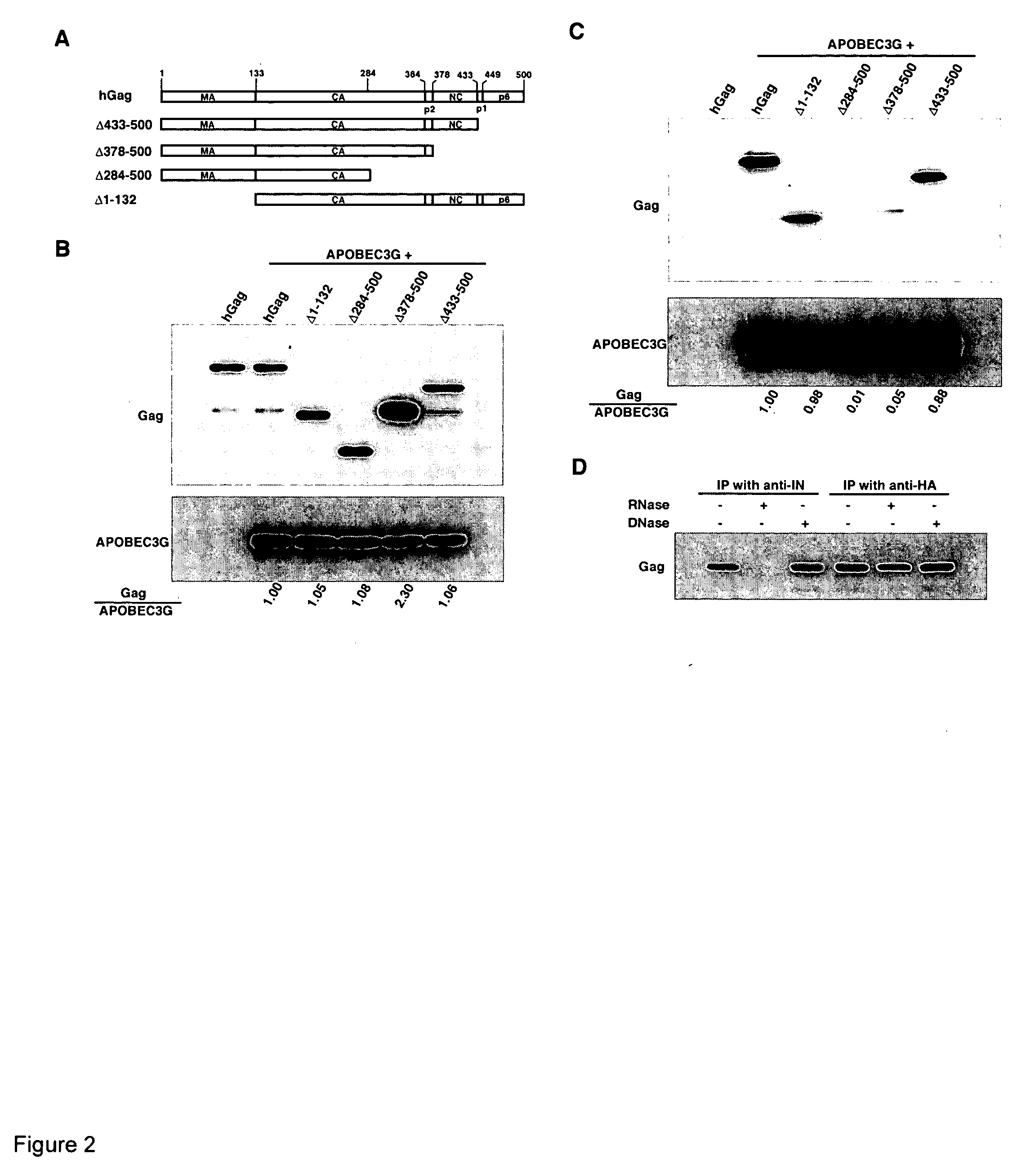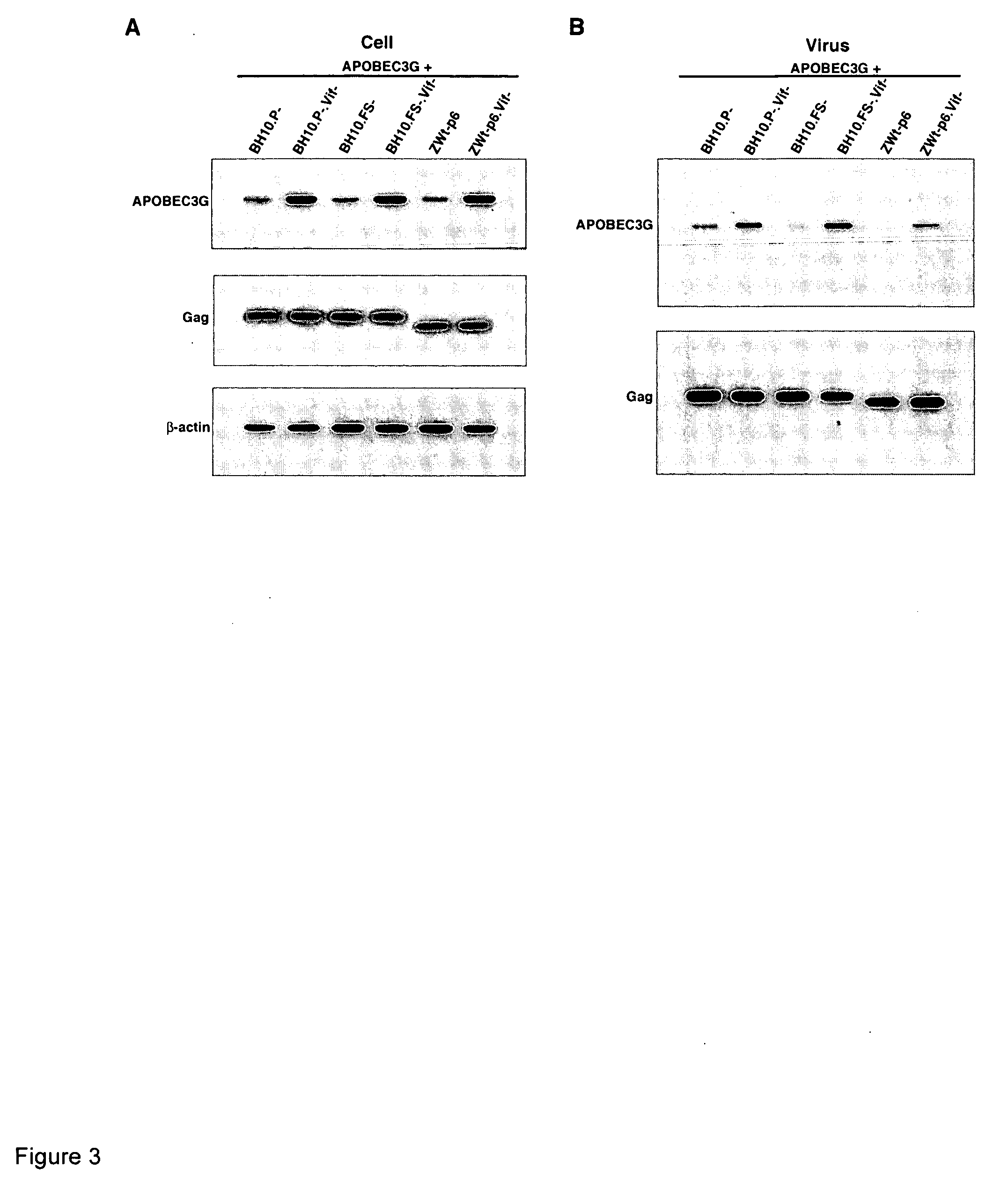Inhibition of the tRNALys3-primed initiation of reverse transcription in HIV-1 by APOBEC3G
- Summary
- Abstract
- Description
- Claims
- Application Information
AI Technical Summary
Benefits of technology
Problems solved by technology
Method used
Image
Examples
example 1
Experimental Procedures
[0144] Plasmid construction—SVC21BH10.P—is a simian virus 40-based vector that contains full-length wild-type HIV-1 proviral DNA containing an inactive viral protease (D25G), and was obtained from E. Cohen, University of Montreal. SVC21BH10.FS—contains mutations at the frameshift site, (i.e., from 2082-TTTTTT-2087 to 2082-CTTCCT-2087), which prevents frameshifting during the translation of Gag protein, and generates viruses that contain Gag, but not Gag-Pol (25). ZWt-p6 encodes a full-length HIV-1 genome, in which the nucleocapsid sequence has been replaced with a yeast leucine zipper domain (26). BH10.Vif−, BH10.P-.Vif−, BH10.FS-.Vif− and ZWt-p6.Vif− were generated by introducing a stop codon right after ATG of the Vif reading frame at 5043, using a site-directed mutagenesis Kit (Stratagene) with the following pair of primers: 5′-AGA TCA TTA GGG ATT TAG GM AAC AGA TGG CAG (SEQ ID NO: 2, and 5′-CTG CCA TCT GTT TTC CTA AAT CCC TAA TGA TCT (SEQ ID NO; 3).
[0145...
example 2
Incorporation of APOBEC3G into Gag VLPs
[0157] 293T cells were co-transfected with a plasmid coding for human APOBEC3G containing a C-terminal HA tag, and plasmid containing wild type or mutant HIV-1 proviral DNA. BH10.Vif− and BH10.P-.Vif− both contain a stop codon immediately after the initiation ATG codon of the Vif reading frame, and BH10P-contains an inactive viral protease. hGag contains a humanized HIV-1 Gag gene (i.e., codon usage optimized for translation in mammalian cells (27)), and only wild type HIV-1 Gag and Gag VLPs are produced (25). The cell lysates of transfected cells were analyzed by Western blots (FIG. 1A), using anti-HA (top panel), anti-β-actin (middle panel) and anti-Vif (bottom panel) antibodies as probes. Vif is detected only in cells transfected with BH10. In cells producing virions or Gag VLPs lacking Vif, APOBEC3G is is strongly expressed, while in cells producing BH10, very little APOBEC3G is seen in the cytoplasm. The viruses produced from these cells ...
example 3
The Nucleocapsid Sequence within Gag is Required for the Viral Packaging of APOBEC3G
[0159] A series of Gag deletion constructs were used to identify the motif within Gag involved in the incorporation of APOBEC3G into viruses. These constructs are shown in FIG. 2A. 293T cells were cotransfected with APOBEC3G and wild-type or mutant Gag constructs, and cells were lysed in RIPA buffer. Western blots of cell lysates (FIG. 2B) were probed with anti-CA (upper panel) or anti-HA (lower panel). The first lane represents cells transfected with hGag alone. All Gag mutants were expressed at similar levels in the cytoplasm, except for the 378-500 construct. This Gag has NC, p1 and p6 deleted from the C-terminus, and is expressed 2-3 fold higher than full-length Gag.
[0160] Most of these mutant Gag molecules are impaired in their ability to form extracellular particles due to the absence of membrane- or RNA-binding regions. The interaction between APOBEC3G and mutant Gag species was therefore in...
PUM
| Property | Measurement | Unit |
|---|---|---|
| Current | aaaaa | aaaaa |
| Current | aaaaa | aaaaa |
| Current | aaaaa | aaaaa |
Abstract
Description
Claims
Application Information
 Login to View More
Login to View More - R&D
- Intellectual Property
- Life Sciences
- Materials
- Tech Scout
- Unparalleled Data Quality
- Higher Quality Content
- 60% Fewer Hallucinations
Browse by: Latest US Patents, China's latest patents, Technical Efficacy Thesaurus, Application Domain, Technology Topic, Popular Technical Reports.
© 2025 PatSnap. All rights reserved.Legal|Privacy policy|Modern Slavery Act Transparency Statement|Sitemap|About US| Contact US: help@patsnap.com



